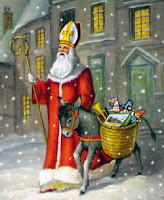 |
| Image = Abbey-Roads |
By Art Cashin
On this day (+1) in about 705 A.D., the Nordic tribes of Europe, recently converted to Christianity, began to adopt a theologically un-definable affection to an Archbishop who had existed three centuries before in an area east of Greece. Legend says he was as wise as they come. And certainly he was devout. But was that enough to make him a big hit?
He did have the added benefits of being the designated patron saint of scholars (ain't we all); merchants (a popular Nordic pastime); sailors (the other Viking pastime) and children. He had gained the latter role through the legend that he had saved three dowry-less young girls by dropping jewels into their home through an open window.
So, over the next thousand years, these Nordic tribes would recall his love of children and his generosity by giving gifts to their children and the poor on Saint Nicholas’s feast day - December 6th. When the Dutch came to America, they brought their gift giving "Sinte Klaus" with them. America moved the gift giving day to Christmas and mispronounced his name to Santa Claus.
Of course by this time Nordic and American winters had made open windows rather impractical in December. So the chimney became the logical point of entry. And since cold floors tended to make you reach for your stockings (hung to dry by the fire) they became the logical place to hide the jewels (gifts).
To celebrate the feast of good old St. Nick go to the Rooftop Inn and sip enough well-laced eggnog to make your nose look like Rudolph's. But don't get out of line or they'll put coal in your stocking.
Many thanks to Mr. Cashin and UBS Financial Services who graciously allow his historical musings to be republished on this site. To enjoy more of Art's posts simply click on "Cashin's Comments" in the label section on the sidebar.
No comments:
Post a Comment
Thanks for making a comment. We love feedback.
Note: Only a member of this blog may post a comment.